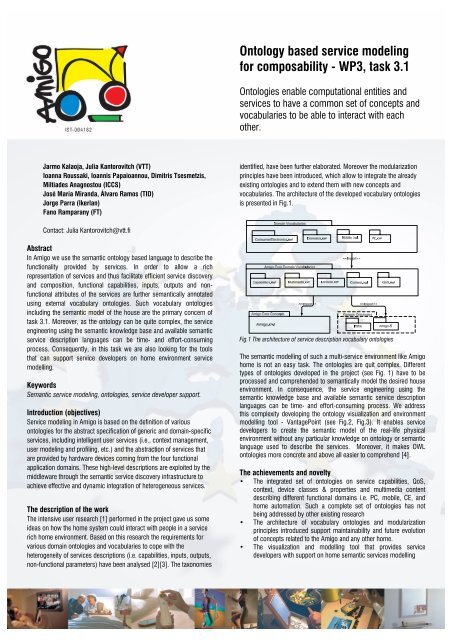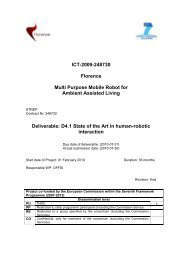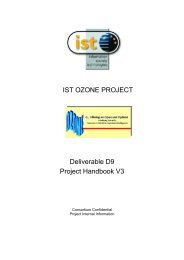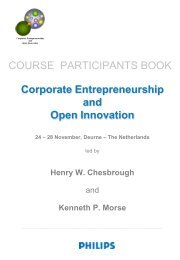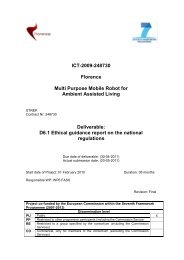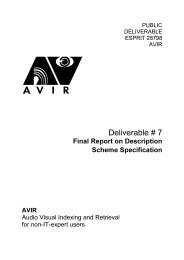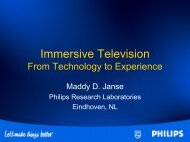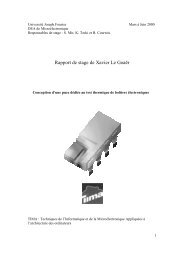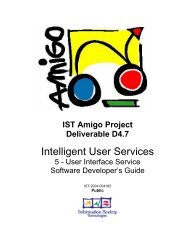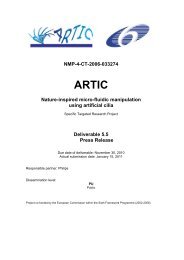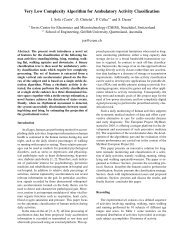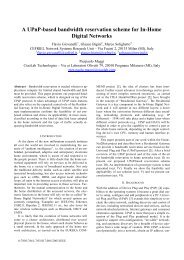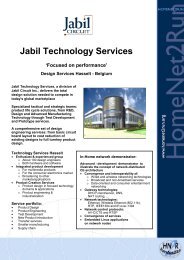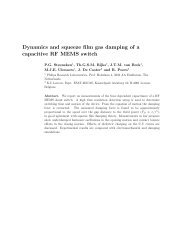Ontology based service modeling for composability ... - CiteSeerX
Ontology based service modeling for composability ... - CiteSeerX
Ontology based service modeling for composability ... - CiteSeerX
Create successful ePaper yourself
Turn your PDF publications into a flip-book with our unique Google optimized e-Paper software.
<strong>Ontology</strong> <strong>based</strong> <strong>service</strong> <strong>modeling</strong><br />
<strong>for</strong> <strong>composability</strong> - WP3, task 3.1<br />
Ontologies enable computational entities and<br />
<strong>service</strong>s to have a common set of concepts and<br />
vocabularies to be able to interact with each<br />
other.<br />
Jarmo Kalaoja, Julia Kantorovitch (VTT)<br />
Ioanna Roussaki, Ioannis Papaioannou, Dimitris Tsesmetzis,<br />
Miltiades Anagnostou (ICCS)<br />
José María Miranda, Álvaro Ramos (TID)<br />
Jorge Parra (Ikerlan)<br />
Fano Ramparany (FT)<br />
identified, have been further elaborated. Moreover the modularization<br />
principles have been introduced, which allow to integrate the already<br />
existing ontologies and to extend them with new concepts and<br />
vocabularies. The architecture of the developed vocabulary ontologies<br />
is presented in Fig.1.<br />
Contact: Julia Kantorovitch@vtt.fi<br />
Abstract<br />
In Amigo we use the semantic ontology <strong>based</strong> language to describe the<br />
functionality provided by <strong>service</strong>s. In order to allow a rich<br />
representation of <strong>service</strong>s and thus facilitate efficient <strong>service</strong> discovery<br />
and composition, functional capabilities, inputs, outputs and nonfunctional<br />
attributes of the <strong>service</strong>s are further semantically annotated<br />
using external vocabulary ontologies. Such vocabulary ontologies<br />
including the semantic model of the house are the primary concern of<br />
task 3.1. Moreover, as the ontology can be quite complex, the <strong>service</strong><br />
engineering using the semantic knowledge base and available semantic<br />
<strong>service</strong> description languages can be time- and ef<strong>for</strong>t-consuming<br />
process. Consequently, in this task we are also looking <strong>for</strong> the tools<br />
that can support <strong>service</strong> developers on home environment <strong>service</strong><br />
modelling.<br />
Keywords<br />
Semantic <strong>service</strong> <strong>modeling</strong>, ontologies, <strong>service</strong> developer support.<br />
Introduction (objectives)<br />
Service <strong>modeling</strong> in Amigo is <strong>based</strong> on the definition of various<br />
ontologies <strong>for</strong> the abstract specification of generic and domain-specific<br />
<strong>service</strong>s, including intelligent user <strong>service</strong>s (i.e., context management,<br />
user <strong>modeling</strong> and profiling, etc.) and the abstraction of <strong>service</strong>s that<br />
are provided by hardware devices coming from the four functional<br />
application domains. These high-level descriptions are exploited by the<br />
middleware through the semantic <strong>service</strong> discovery infrastructure to<br />
achieve effective and dynamic integration of heterogeneous <strong>service</strong>s.<br />
The description of the work<br />
The intensive user research [1] per<strong>for</strong>med in the project gave us some<br />
ideas on how the home system could interact with people in a <strong>service</strong><br />
rich home environment. Based on this research the requirements <strong>for</strong><br />
various domain ontologies and vocabularies to cope with the<br />
heterogeneity of <strong>service</strong>s descriptions (i.e. capabilities, inputs, outputs,<br />
non-functional parameters) have been analysed [2][3]. The taxonomies<br />
Fig.1 The architecture of <strong>service</strong> description vocabulary ontologies<br />
The semantic modelling of such a multi-<strong>service</strong> environment like Amigo<br />
home is not an easy task. The ontologies are quit complex. Different<br />
types of ontologies developed in the project (see Fig. 1) have to be<br />
processed and comprehended to semantically model the desired house<br />
environment. In consequence, the <strong>service</strong> engineering using the<br />
semantic knowledge base and available semantic <strong>service</strong> description<br />
languages can be time- and ef<strong>for</strong>t-consuming process. We address<br />
this complexity developing the ontology visualization and environment<br />
modelling tool - VantagePoint (see Fig.2, Fig.3). It enables <strong>service</strong><br />
developers to create the semantic model of the real-life physical<br />
environment without any particular knowledge on ontology or semantic<br />
language used to describe the <strong>service</strong>s. Moreover, it makes OWL<br />
ontologies more concrete and above all easier to comprehend [4].<br />
The achievements and novelty<br />
• The integrated set of ontologies on <strong>service</strong> capabilities, QoS,<br />
context, device classes & properties and multimedia content<br />
describing different functional domains i.e. PC, mobile, CE, and<br />
home automation. Such a complete set of ontologies has not<br />
being addressed by other existing research<br />
• The architecture of vocabulary ontologies and modularization<br />
principles introduced support maintainability and future evolution<br />
of concepts related to the Amigo and any other home.<br />
• The visualization and modelling tool that provides <strong>service</strong><br />
developers with support on home semantic <strong>service</strong>s modelling
• Multimedia content ontology. The multimedia content models will<br />
be iteratively refined with the objective of composing <strong>service</strong>s that<br />
use multimedia content as input or output. Furthermore, the<br />
models will be enriched by analyzing existing different models of<br />
multimedia content concepts, such as DublinCore, MPEG, etc.,<br />
and incorporating properties that match application requirements<br />
related to content.<br />
Fig.2 The components of VantagePoint tool<br />
• Context and QoS support. The context and QoS vocabulary<br />
ontologies will be revised and enhanced <strong>based</strong> on the<br />
requirements of the Amigo components that will use them. These<br />
components include the <strong>service</strong>s of T4.1 (Context Management<br />
Service), T4.2 (User Modeling & Profiling Service), T3.2 (Amigo-<br />
Aware Services), etc. The objective here is on the one hand to<br />
allow <strong>service</strong> providers and developers to represent the necessary<br />
context properties and support context-aware <strong>service</strong> creation;<br />
and on the other hand to provide to <strong>service</strong> providers the means<br />
to represent the QoS properties of the <strong>service</strong>s they offer in order<br />
to help their customers in the <strong>service</strong> selection process.<br />
Moreover the further work on ontology visualization and environment<br />
modelling tool towards the dynamicity and real-time featuring will be<br />
accomplished.<br />
Fig.3 The isometric view of test Amigo house<br />
Conclusion and Future work<br />
For the next period of the project, our work will be focus mainly on the<br />
refinement of the developed ontologies towards the application<br />
prototype implementation and experimentation especially <strong>for</strong> the<br />
following domains:<br />
• Home automation. The developed classifications will be further<br />
extended with the functional capabilities of <strong>service</strong>s provided by<br />
devices found in this domain.<br />
References<br />
1. Rocker C., Streitz, N., Janse., M, Portolan., N., User<br />
Requirements <strong>for</strong> intelligent Home Environments: A Scenario<br />
Driven Approach and Empirical Cross Cultural Study (2005).<br />
SOCEUSAI 2005 Smart Objects & Ambient Intelligence<br />
2. Kalaoja, J., Kantorovitch, J., Carro, S., Miranda, J.M., Ramos,<br />
A., Parra, J.: The vocabulary ontology engineering <strong>for</strong> the<br />
semantic modelling of home <strong>service</strong>s. (2006) 8 th International<br />
conference on Enterprise In<strong>for</strong>mation and Systems<br />
3. Tsesmetzis D., Roussaki I., Papaioannou I., Anagnostou M.,<br />
QoS awareness support in Web-Service semantics (2006).<br />
IEEE International Conference on Internet and Web<br />
Applications and Services, Guadeloupe, French Caribbean<br />
4. Kalaoja J., Kantorovitch J., Piirainen T., and Niskanen I., A<br />
support tool <strong>for</strong> the semantic ontology <strong>based</strong> <strong>service</strong><br />
engineering (2007). Submitted to FASE’07, 26-30 March,<br />
Braga, Portugal<br />
Additional In<strong>for</strong>mation<br />
http://www.hitech-projects.com/euprojects/amigo


